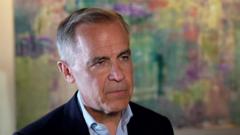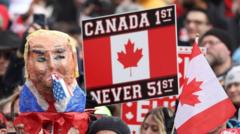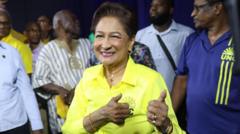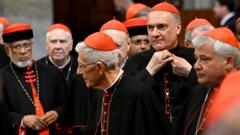As the campaign reaches its climax, the battle for voter loyalty intensifies, with political fortunes shifting in unexpected ways amidst escalating discussions about the U.S. and domestic issues.
Historic Political Shakeup in Canada: Liberals Regain Ground Amid Election Tensions
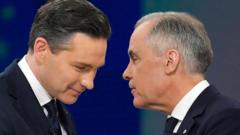
Historic Political Shakeup in Canada: Liberals Regain Ground Amid Election Tensions
As tensions with the U.S. escalate, Canadians face a dramatic electoral landscape in their upcoming election.
In a charged environment leading up to Canada's pivotal election, political allegiances appear to be in flux, reflecting a palpable urgency among voters. Mark Carney, the Liberal leader and a seasoned central banker, is facing pushback, especially in the wake of threats from U.S. President Donald Trump that have created a wave of patriotism and unease among Canadian citizens. Carney's speeches, punctuated by fervent calls from supporters, echo the disdain many feel toward American interference, with chants of “Never!” resounding in halls where he speaks.
Conversely, Conservative leader Pierre Poilievre channels frustrations over a decade of Liberal governance, amplifying calls for change within Canada. His message has resonated with younger generations who fear for their financial futures as they witness their children face steep barriers to home ownership.
In a turnaround of fortune, Carney ascended to the Liberal leadership after Justin Trudeau's unexpected resignation, moving the Liberals into a competitive position following precarious polling for much of the prior year. Some expected the Conservative Party to routinely secure victory given previous momentum, but the intricate dynamics of voter sentiments have transformed the political scene.
Polling data prior to election day suggests that the Liberals have narrowed distance with the Conservatives, fueled in part by Carney's calming presence, which many view as essential given the looming economic threats from the U.S. Critics of Carney express skepticism about his ability to enact change as he inherits a party with mixed public sentiment.
The political mapping of the nation shows a fragmented but engaged electorate that is shifting back toward the two dominant parties, with smaller parties seemingly at risk of losing ground. Notably, the New Democratic Party (NDP) has shifted its strategy to encourage strategic voting to thwart potential Liberal dominance in Parliament.
While economic issues dominate the campaign trail, little attention has followed significant topics like climate or immigration, as the focus intensifies on the implications of U.S. tariffs and trade relations, sparking a debate on how best to safeguard Canada's interests. The candidates agree on a need to adjust the country’s dependency on U.S. policies, but diverge substantially on the path forward.
The upcoming election embodies not just a choice between two parties, but a moment that could redefine Canada's identity amidst external pressures. Carney's promise of stability stands in contrast to Poilievre's calls for drastic change, setting the stage for a defining election outcome that will haunt or herald the future direction of Canadian governance.
Conversely, Conservative leader Pierre Poilievre channels frustrations over a decade of Liberal governance, amplifying calls for change within Canada. His message has resonated with younger generations who fear for their financial futures as they witness their children face steep barriers to home ownership.
In a turnaround of fortune, Carney ascended to the Liberal leadership after Justin Trudeau's unexpected resignation, moving the Liberals into a competitive position following precarious polling for much of the prior year. Some expected the Conservative Party to routinely secure victory given previous momentum, but the intricate dynamics of voter sentiments have transformed the political scene.
Polling data prior to election day suggests that the Liberals have narrowed distance with the Conservatives, fueled in part by Carney's calming presence, which many view as essential given the looming economic threats from the U.S. Critics of Carney express skepticism about his ability to enact change as he inherits a party with mixed public sentiment.
The political mapping of the nation shows a fragmented but engaged electorate that is shifting back toward the two dominant parties, with smaller parties seemingly at risk of losing ground. Notably, the New Democratic Party (NDP) has shifted its strategy to encourage strategic voting to thwart potential Liberal dominance in Parliament.
While economic issues dominate the campaign trail, little attention has followed significant topics like climate or immigration, as the focus intensifies on the implications of U.S. tariffs and trade relations, sparking a debate on how best to safeguard Canada's interests. The candidates agree on a need to adjust the country’s dependency on U.S. policies, but diverge substantially on the path forward.
The upcoming election embodies not just a choice between two parties, but a moment that could redefine Canada's identity amidst external pressures. Carney's promise of stability stands in contrast to Poilievre's calls for drastic change, setting the stage for a defining election outcome that will haunt or herald the future direction of Canadian governance.

